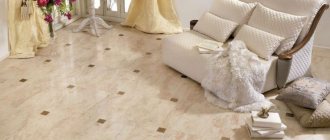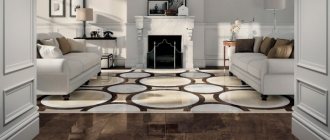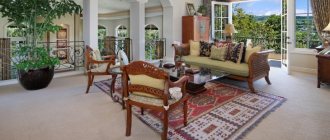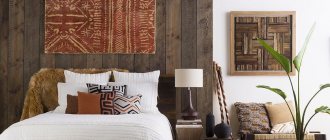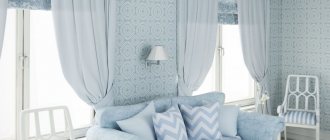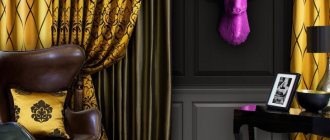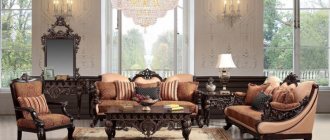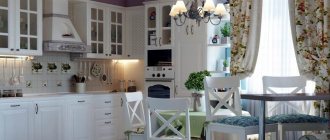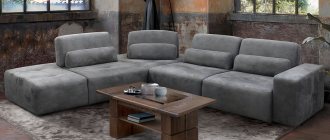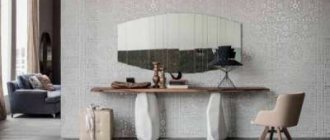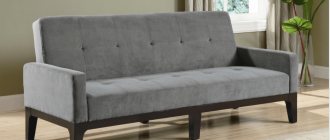The living room is the most important room that requires special attention. It serves as a gathering place for the whole family and welcomes guests. The carpet has always been an integral part of it. It was considered a sign of family wealth; it was used to cover the floor and hang it on the wall. This time has passed; today carpets are popular only in the center of the living room on the floor.
A good rug creates a warm atmosphere, coziness and comfort in the main room of the house. The main thing is to choose the right one among the huge variety.
Features of carpets
Even the most stylish living room design without carpet looks uncomfortable and cold.
In the interior, textiles play an important role:
- insulate the floor;
- protect from dirt;
- are decoration.
A real high-quality carpet has a number of differences from other types of coverings.
The main ones include:
- finished design and drawing;
- processed edges;
- used for decoration;
- laid on the floor over linoleum, parquet, etc.
Oval and round carpets in the living room
Textiles and carpeting in the interior of a room are the finishing touches to its improvement. Finding the right carpet is not that easy. And no matter how designers and psychologists say about harmony, oval and round carpets will not be appropriate in every room. Of course, the choice of the majority is the classic regular shapes, but there are several techniques with which you can harmoniously fit round carpets into the interior.
Article on the topic: Winter planting of large coniferous trees: carefully and safely
The main purpose of a carpet in the living room is to create additional comfort for both the owner and guests. When choosing a carpet for a hall or living room, you should take into account the color scheme, dimensions of the room and the arrangement of furniture. For the interior, the carpet can be considered in two aspects:
- - carpet only as a functional item;
- — the carpet as an object of attention.
The carpet for the living room must be selected taking into account how the room will look with one or another variation.
If the first task is set, then the choice of color and texture should be difficult to match with upholstered furniture. Using this technique, you can combine the carpet with other interior items: match it with curtains, cabinet furniture, walls, etc. In this case, a carpet, be it round or square, located in the center of the room, will visually unite all the interior details into a single whole.
If you need to solve the second problem, then the choice of carpet design should be contrastingly different from the rest of the design. This looks especially good if all the components of the interior are in dull colors. Soft carpeting can add bright colors and emphasize its originality. Many models with modern designs and current color schemes do not limit the choice.
When choosing the shape of the carpet, you need to focus on the size of the room itself, the existing furniture, as well as the style of the interior as a whole. Designers advise that in order to harmoniously fit the surrounding geometry on the floor, the carpet must be supported in parallel with other circles in the interior. For example, a round coffee or dining table, round upholstered furniture. An oval carpet would look great in a living room where the entrance is decorated with an arch, or there are round columns or other “circles”.
A carpet as a way of zoning a room is another point in favor of round and oval shapes. Even in a small room where you can get by with one classic carpet for the entire area, adding another small round carpet can highlight part of the interior. For example, put it under a chair by the window or near a computer desk against the wall. This will create not only originality, but also comfort.
Related article: Under what conditions does the dew point occur?
Types of carpets by type of production
The quality and cost of products are influenced by 2 factors - material and type of manufacture. Based on the material, they are divided into natural and synthetic.
Carpets are produced in 2 ways: machine and manual.
- Machine-made - has become most widespread, because handmade is highly valued. The products are high-density, have a clear pattern and regular lines. Using this method, the company produces several kilometers of standard-quality canvas; they are relatively inexpensive. Machine production allows you to create high quality products; sometimes such carpets are passed off as handmade.
- Handmade - involves the use of only natural materials. It is impossible to find two completely identical carpets. Their density may not be uniform, minor defects and small discrepancies in the pattern are allowed. The manufacturing time depends on the complexity of the pattern; one product can be created over a long period of time, the price is appropriate - about a thousand dollars per square meter.
Types of carpets according to manufacturing technology
According to production technology, they are divided into 3 types.
Woven carpets
Expensive products, they are made by simultaneously joining the warp and pile threads. The process takes a long time, and the price depends on it. Woven coverings are very dense and durable.
Hand-made products are lint-free fabrics with a pattern, made by intertwining working thread with warp threads.
With the factory method, the pile is woven together with the working thread and can have different heights.
Needlepunched
Lint-free fabrics are inferior in appearance to carpet products from other production methods. They are made by driving threads into the warp using special needles without eyes. The threads become tangled and intertwined, forming a thick, dense coating, which is then additionally fixed. This gives strength to the pile; needle-punched carpets have high resistance to wear.
Tufted
Looped coverings, the technology consists of stitching the base with pile threads. As a result, loops are formed on the front side; they can be of different heights, whole or cut. They are fixed on the reverse side with latex, after which a woven or foam secondary base is applied. Using the tufting method, you can create three-dimensional designs.
What materials are they made from?
Since ancient times, quality products have been made from natural materials, usually silk or wool. In modern conditions, decent carpets are also produced from artificial raw materials. Each of them has its own negative and positive qualities.
Wool
A classic, expensive option. Wool carpets for the living room are made from warm and pleasant to the touch sheep wool. Exclusive products are made from goat and camel hair.
Main advantages:
- elastic, resistant to the spread of fire;
- retain heat well and absorb sound;
- noble and respectable appearance;
- long service life (up to 40-50 years);
- bright color, practically do not fade.
Disadvantages of coverage:
- high price;
- rapid contamination and frequent cleaning;
- tendency to mold;
- allergic;
- susceptible to moth attacks.
With the help of various antifungal, dirt-repellent and anti-moth impregnations, specialists cope with these disadvantages.
Silk
Silk products belong to the natural category. It is based on fiber produced by the caterpillars of the silkworm butterfly. Thanks to the flexible thread, clear and detailed designs are created. The coating is very expensive, but it is completely justified.
Positive characteristics:
- incredible wear resistance and strength;
- chic appearance and pleasant surface;
- smoothness and characteristic shine.
Negative sides:
- are even more expensive than wool ones;
- tendency to fade;
- possibility of shedding.
Silk products are valued as works of art and are very beautiful. You should not lay such a carpet on the floor in the living room.
Cotton and jute
Cotton and jute products fall into the natural and eco-friendly category. Carpets are rarely made from pure cotton; wool is usually added to them. Jute is a family of shrubs that includes the well-known linden tree. It makes very durable fabrics. Cotton and jute coverings are very affordable.
Advantages of a cotton product:
- high thermal conductivity;
- breathability;
- safety for allergy sufferers;
- ease of cleaning.
The disadvantages include:
- low elasticity;
- tendency to bruise;
- shrinkage and deformation.
The disadvantages of jute include the effect of water on the carpet: when liquid gets in, it shrinks.
Viscose
The viscose option is perfect for a living room that is always crowded. Viscose fiber rugs lend themselves well to coloring; they are colorful and bright. Due to its characteristic shine, it is called “artificial silk”.
Such coatings have:
- high durability;
- wear resistance;
- do not rub;
- do not wrinkle;
- are not electrified.
The downside is the ability to absorb moisture, losing some of its positive performance qualities.
Polypropylene
A very common synthetic material. The fiber thread is absolutely smooth and does not allow dust and dirt to enter its structure. Polypropylene is very unpretentious, which is valued in the modern world. Nowadays, products made from it are quite common, they are very easy to care for - just vacuum the surface.
Living room carpets made from such raw materials have a number of advantages:
- they are durable;
- light and inexpensive;
- do not fade in the sun;
- practically not erased;
- not exposed to moths and microorganisms.
The disadvantages usually include:
- greater flammability than wool carpets;
- tendency to wrinkle;
- high level of electrification;
- low wear resistance;
- short service life (maximum 4-5 years).
Polypropylene also includes a hit set treated with anti-mud and antiseptic agents. This is the only material on the market that is inherently antistatic.
Polyester
Polyester carpets are very similar to wool. Acrylic fiber was conceived in the carpet industry as an analogue to wool. Acrylic is a type of polyester fabric along with microfiber and polyester. It is used today in the manufacture of: carpets, clothes, blankets.
Acrylic products have many advantages:
- soft and light;
- almost do not deform or wrinkle;
- dry quickly and are easy to clean;
- fire resistant and do not fade;
- non-allergenic and relatively inexpensive.
Among the disadvantages of such a floor accessory:
- electrification;.
- wear resistance is inferior to its natural analogue - woolen carpets.
Polyamide
Polyamide is a common synthetic material; it combines a whole group of substances. Nylon is usually used to produce carpets. One of the advantages of products made from it is the shine of the fibers, which gives an unusual decorative effect.
Among the advantages of coatings:
- strength and wear resistance;
- durability and elasticity;
- bright patterns and preservation of shape;
- good fire-fighting properties,
- easy to care for and quick to dry.
The disadvantages usually include:
- susceptibility to sunburn,
- risk of becoming brittle and stiff,
- high level of electrification.
Types of carpets by pile structure
One of the most important parameters is the length and structure of the pile. Carpet products are divided into pile and lint-free. The first ones are cozy and soft; in places with heavy loads it is better to lay lint-free coverings.
Depending on the type of structure, carpets are:
- with cut pile;
- looped;
- combined.
Coverings with cut pile - during the manufacturing process, all the loops are cut, the pile is fluffed, which gives the carpet a special softness.
There are three types of such products:
- short-pile – pile length up to 5 mm;
- medium pile – height within 6-15 mm;
- long-pile – luxurious carpets with a pile of more than 16 mm.
Disadvantages of long pile:
- difficulty in care;
- fragility;
- severe deformation under heavy furniture.
In living rooms it is better to lay carpets with short and medium pile; long-pile ones are most appropriate in the bedroom.
Looped carpet fabrics - the loops on the fabric remain closed, this gives the product a very attractive appearance.
Depending on the height of the loops, they are divided into two types:
- single-level;
- multi-level.
The second option looks more impressive; loops of different heights allow you to create original three-dimensional patterns on the surface.
Such products:
- do not wrinkle;
- wear less;
- retain their original appearance longer.
Combined fabrics consist of whole and cut loops. Whole ones are usually inferior in height to cut ones, thanks to this a relief surface is created. Such models look original and serve as interior decoration.
Rectangular carpet for the floor in the living room
The use of rectangular or oval-shaped carpets near the sofa is the most relevant.
The floor can be completely or partially covered. But to make the product look more harmonious, experts advise leaving at least 20 cm of free space to the edge of the walls. Note! Living room in a classic style: review of modern ideas (70 design photos)
Related article: Balcony finishing with sandwich panels
An excellent option for making the carpet stand out from the general look is a bright border strip that matches the color scheme of some design elements.
Thus, the product will not merge with the floor and will perform not only a technical function, but will also serve as decorative decor.
Sizes and shapes
Any carpet will not work for the living room floor. Its size is chosen depending on the dimensions of the room and the tasks assigned to it.
Conventionally, carpets can be divided into:
- small - area up to 3 sq.m;
- medium - having an area of 3-6 sq.m;
- large - with an area of 6 sq.m.
To determine the size of the product, you can use colored tape to lay out the outline of the carpet on the floor. This will help to evaluate the dimensions of the coating and its compatibility with the interior.
Small products are used to highlight individual areas in the room and are purchased as bright accessories that create accents in the room. The room will look more harmonious if you place a coffee table on the carpet.
It is better to place a 2x3 or 3x4 m rug in the center of a spacious hall, arrange sofas and armchairs around it, and place a coffee table in the middle.
Canvases that are too large, having overall dimensions of 2.5 meters or more, attract maximum attention and must be treated with caution. For bright and stylish interiors, it is better to choose plain carpets with a low-contrast and calm pattern.
The shapes of the carpet can be very different, it all depends on the layout of the room and the interior:
They can be:
- oval,
- rectangular,
- square,
- round,
- diamond-shaped
- even polygonal.
For those who like strict straight lines (a square or rectangular coffee table, seats), a carpet of the same shape is suitable.
If the pieces of furniture have a round or curved shape, then a round or oval product would be an excellent solution.
Diamond or polygon shapes are considered a fashionable trend. It is appropriate now to use abstract figured coverings.
When choosing a form, it is advisable to follow the following recommendations:
- Rectangular rugs mark out the seating area next to the sofa.
- Round - looks harmonious with a round chandelier hanging above it (suitable only for a spacious room).
- A carpet will make the room visually elongate.
- Accents in the room can be placed using round products.
- Often the coating is matched to the shape of the coffee table (round, square, rectangular).
- All legs of the coffee table near the sofa should be on the carpet.
- A textile covering with long pile will give the living room more warmth and comfort.
- A round product visually reduces the size of the room. If you lay a rug that matches the floor, this effect can be avoided.
- Covering the entire area of the room without ornament will visually make the room larger.
Color and style
The choice of color scheme and carpet pattern for the living room is very important. The whole family gathers in it, and the covering should bring warmth and comfort to the main room of the house.
The following points will help you choose a carpet for the living room floor:
- In a room with bright furniture, you should choose textile coverings in neutral tones.
- If you have upholstered furniture with multi-colored upholstery, the rug should be monochromatic and visually discreet, its tone should match one of the colors of the furniture upholstery.
- A light or bright and catchy rug looks harmonious on the surface of a dark floor.
- A kind of “set” of curtains and carpet of the same color will look good.
- A living room decorated in a warm palette requires the same tone of the carpet.
- The dark interior is combined with light flooring.
- A carpet product can match the tone with other decorative elements: rugs, sofa cushions.
- A living room in beige tones can be decorated with a chocolate or coffee-colored canvas.
- A carpet that is a shade darker or lighter than the floor covering in the room is ideally perceived.
- It is better not to match the rug to the walls; in this case, the interior may look boring.
- The geometric pattern on the carpet should go in the same direction as the shade of the pattern on the furniture.
- Horizontal stripes will make the room visually wider.
When selecting, you should take into account compliance with the interior style of the living room:
- Modern - will look perfect with a canvas of a classic square or rectangular shape, plain color, pastel colors.
- Vintage - you can play with light flooring with small flowers.
- Hi-Tech - combined with a plain canvas of a cold shade.
- Country - looks harmonious with a decorative textile floor covering with a bright color print; plain products in a brown tone are also possible.
- A classic interior will look advantageous with spectacular ornate patterns made in beige and gold shades.
- African style - loves animal prints, products with a zebra or giraffe print will look appropriate. Bright floor elements with geometric patterns are suitable.
- Japanese interior - accept a square rug with a plain surface, without any decorative elements.
- Scandinavian interior - combined with white or black coating.
How to Arrange a Carpet in the Living Room
From photographs of different interiors, it seems that the carpet in the living room can be arranged in different ways. But in reality there are only a few good options. Choose the one that suits your interior.
Carpet across the entire width of the room
This is probably the most popular option for placing a carpet, as it does not require much thought. It is only important to choose it according to the size of the room and follow the 30 centimeter rule, which we wrote about above.
Photo: homedecorators.com
All front legs on carpet
There is a compromise option: the carpet takes up almost the entire area of the room, leaving a small space free around the edges. If you want the rug to lay this way, place it in the center of the living room (under an armchair or coffee table) and arrange the furniture so that the front legs are on the rug and the back legs are on the floor. Designers recommend installing furniture with a spacing of 20-25 centimeters. This combination makes the interior more stylish.
What to look for when choosing
Once the functions and size of the carpet have been determined, special attention should be paid to the quality and density of the product.
Distinctive features of a quality product:
- absence of protruding threads and loops, stains;
- clear and uniform pattern over the entire surface;
- does not emit an unpleasant odor, this applies to both natural and synthetic products.
To check the density, you need to slightly bend the corner and look at the fold line:
- the base is visible - low density, will not last long;
- high density of the carpet - it is warmer and more wear-resistant.
Each carpet must have a label with a description of the product, manufacturer, expiration date and other necessary information.
Recommendations from professionals
Fashion is constantly changing, designers offer something new and unusual every year, and the choice of carpets is now quite large.
The following models are trending:
- complex asymmetrical shapes, for example, in the form of circles or rectangles, randomly stacked on top of each other;
- plain with a relief expressive pattern;
- large-sized coverings with large patterns and contrasting colors;
- products with images of landscapes and portraits.
Where to place
A couple of decades ago, the gold standard for using carpet was to completely cover the entire area of the room (sometimes even the wall). This was done to preserve heat. Today there is no need for this - the room looks more attractive when the carpet covers only part of it. This allows it to perform another function - zoning the room.
Using carpet in a large living room, you can distinguish zones:
- relaxation with a sofa and armchairs;
- near the fireplace;
- lunch;
- for hobbies and interests.
The placement can be approached functionally - the place of the carpet is where the feet touch the floor when a person sits.
Carpets that should not be laid in the living room
Coverings with long pile are undesirable in the living room - their place is in the bedroom. If ease of cleaning is a significant factor, then it is better to choose a canvas with short pile. There are almost no traces of furniture legs left on it.
It is better not to place a covering made of natural material in places where people walk most often.
You should not lay velor products in the living room - they are very sensitive to pressure and even retain foot prints. Frequent traffic will quickly render them unusable.
How to choose a round carpet for a room
When planning to use round and oval carpets in a modern interior, listen to the following tips:
- A round carpet in the interior creates a visual sense of harmony. The effect can be enhanced by using “binding objects”. To highlight a certain object, match it with a round rug that matches in texture or color.
- Use round rugs to soften the rough edges of a minimalist space. This is relevant for any small rooms - oval carpets will help visually expand and decorate the hallway and bathtub.
- Use caution when combining two or more small rugs. Any incorrect combination of them will destroy the harmony of the interior.
- A small round carpet with a diameter of up to one and a half meters will help create a cozy area for work or relaxation. To do this, place it in the corner of the bedroom or office and install a comfortable chair with a floor lamp.
- The geometric shape of a circle or oval is well perceived by the child. Therefore, such products are suitable for children.
